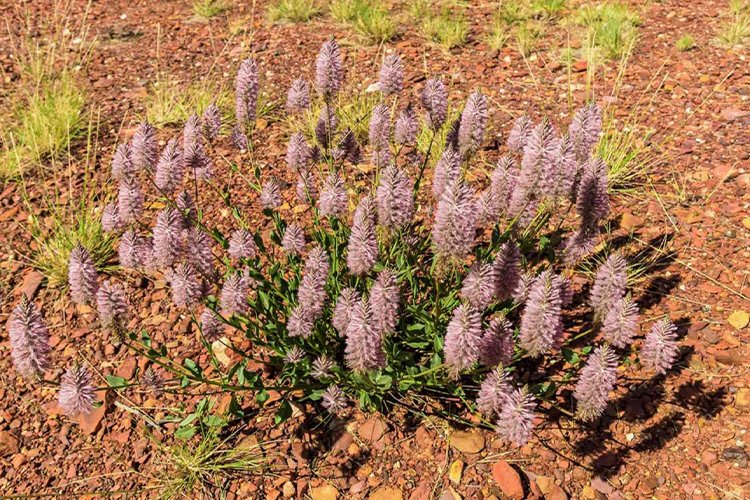
The Ptilotus plant (Ptilotus exaltatus) is a newer addition to the horticultural scene in North America and is known for its unique and spectacular flower spires of thick, plume-like, bottlebrush-shaped flowers in a beautiful silvery pink hue.
Known by the common name Pink Mulla Mulla, this cone-shaped plant is one of the largest and rarest of over a hundred species within the parent genus Ptilotus.
These plants have ornamental silvery-green foliage that is thick and fleshy. Its soft plumes are about four inches tall and fall gracefully over the leathery foliage.
Native to the dry, arid plains of Australia, the long-lasting flowers of Ptilotus appear soft and fluffy, but feel quite hard and bristly. Their texture allows the flowers to withstand various weather conditions quite well. They look similar to the Celosia, and both are members of the Amaranthaceae family.
This herbaceous perennial is often grown as an annual. It serves as an accent plant, often grown in a container as a solitary specimen, but also as part of a larger group of similar flowers to create a truly striking display. They can give your garden a gentle cottage garden look and are also often cut and dried to create arrangements.
The upright growing Ptilotus exaltatus thrives in a sunlit location (provided the soil is well-drained). It is often planted in the middle or end of a bed, where the ptilotus can provide a beautiful contrast to annual flowers.

These sun-loving, drought-tolerant plants are easy to grow and, once established, can be pretty much ignored.
Gardeners should know that these plants are susceptible to root rot. To prevent this often fatal problem, a product that controls fungal pathogens in the soil can be used. If your plant was in a pot that already contained soil contaminated with root rot, the pot should be bleached before reusing it to kill any remaining spores.
The Ptilotus plant needs full sun to survive. For optimal growth, it should receive at least six to eight hours of direct sun.
These are truly drought tolerant plants. The Ptilotus plant rarely needs watering, except for severe drought conditions.
The Ptilotus plant grows best in well-drained, lean and loose soil (it can also be sandy). This should be amended with organic material to provide ideal growing conditions before planting.
These warm weather plants are perfect for anyone living in a hot, dry climate, and they are often grown in the Mediterranean, tropical or subtropical deserts, or temperate climates. Protection from severe frost is crucial, especially for younger Ptilotus plants.
The Ptilous exaltatus is considered a relatively easy-care plant and does not necessarily need additional fertilizer (assuming it was originally planted in average to good quality soil). However, to encourage faster growth, a general-purpose fertilizer can be used.
The Ptilotus exaltatus can generally be propagated by seed. Its profuse flowering and early transition from vegetative to reproductive growth sometimes make it difficult to successfully propagate this plant by cuttings. However, it is possible – just make sure you attempt propagation during the warmest season, preferably when humidity is at its highest.

Of all the Ptilotus varieties, the Exaltatus is known for being rarer, larger, and a little more difficult to grow. Other varieties include:
Ptilous nobilis: Known for its soft, flowing flowers
Ptilous manglesii: Attractive pink-tipped flowers
Ptilous spathulatus: Often used as a ground cover
The flowers of a Ptilotus exaltatus can look ragged as the plant ages. This problem can be remedied by removing all spent flowers to encourage new growth and make your plant look more attractive.
The Ptilotus plant can also be grown in containers with well-draining soil. You just need to make sure the soil dries out completely between each watering.
Because the Ptilotus tends to grow tall in its natural environment (and can almost look like a weed), more compact varieties have been developed that can be used for planting in containers as well as in gardens.